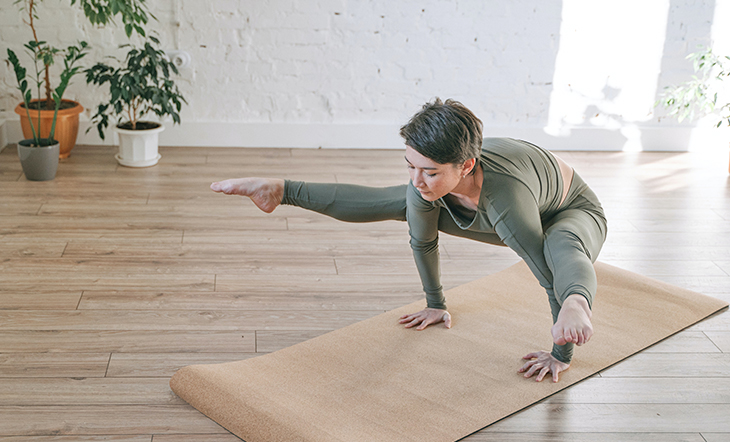6 Ways for Yoga Teachers to Prepare for Unexpected Hiccups During Class
Inevitably, all yoga teachers have had this nightmare about teaching yoga: you’re beyond late for class, the music isn’t working, the Zoom students can’t hear you, or you prepared a Vinyasa class for a Restorative sub opportunity. All eyes...

Inevitably, all yoga teachers have had this nightmare about teaching yoga: you’re beyond late for class, the music isn’t working, the Zoom students can’t hear you, or you prepared a Vinyasa class for a Restorative sub opportunity. All eyes are on you and you need to think fast.
Luckily, there are things that you can do to prepare for the hiccups or unexpected struggles of teaching – and we’ve got these tips for teaching yoga covered for you.
First, take a deep breath. Yoga has prepared you to stay present and remain in-service. And then read on for six common hiccups and the ways you can prepare for them during class.
Tips for Teaching Yoga – Here Are 6 Unexpected Hiccups That Show Up When You’re Teaching Yoga (And How You Can Prepare for Them):
When it comes to tips for teaching yoga, few beat the helpful suggestions of what to do when something goes wrong in class.
1. You’re Asked to Sub a Last Minute Class
A teacher doesn’t show up, or an emergency prevents them from teaching class and you’re asked to step in – last minute – and teach. It happens!
How to prepare:
Here comes one of the best tips for teaching yoga in general: Have a go-to sequence or class. If you work at a studio with different style classes, prepare one emergency class for every style that you can turn to in a pinch.
2. You Don’t Have Time Before Class to Go Over Your Plan
The studio is swamped five minutes before class, there’s technical difficulties to address before class starts, or you were stuck in traffic and unable to get to the studio early. There can be a million scenarios where you can’t prepare for class right before it begins.
How to prepare:
Pre-plan your key poses/moves ahead of time. Even if you don’t have every transition or sequence thought out, knowing where you’re heading can help you physically prepare your students on the fly.
3. The Bluetooth Isn’t Working
We’ve grown accustomed to bluetooth speakers and microphones. But what if it won’t connect? Or, what if it’s an older speaker that doesn’t have bluetooth compatibility?
How to prepare:
Always have your own aux cord and extra dongle (iPhone to aux cord adapter). It’s a simple and effective solution.
Bring your own equipment. Especially when working with a new studio or system, pack your own little speaker and connectors so you won’t be caught empty handed and without music.
4. Your Vinyasa II Class Is Full of First-Timers
The wonderful news? You’re bringing yoga to new people! The hard part? Your arm balance and inversion sequence may not be the most supportive opportunity for first-time yogis.
How to prepare:
Another one of the best tips for teaching yoga: Recognize when it’s necessary to scrap your original game plan and go a different route. Read the room. Do people look like they’re really struggling more than a healthy challenge? Or are they refusing postures altogether?
If it’s clear that many people have never done a Vinyasa before, you may have to pivot and work through common poses more thoroughly. Offer props and modifications.
When all else fails, go back to basics. Even “advanced” yoga practitioners benefit from a Warrior sequence or Tree Pose.
5. There Aren’t Enough Blocks/Props
You planned a class around a specific pose or sequence that requires two blocks but there’s only enough for everyone to have one? Yikes. But don’t worry, we can deal with that.
How to prepare:
Sometimes, a creative way is to partner up and share props! Let your students take turns exploring a posture and maybe even letting them support or receive feedback from each other.
Or, see if you can alter the pose to make it one-block accessible for most and offer the second block just for those who need it.
For example, when working toward Full Splits (Hanumanasana), you may have some people who stay in Half Splits with no blocks or who can use their shin for support.
You can always think a little outside of the box, too. Towels make great straps. Books and heavy water bottles can support us as much as blocks.
6. Someone Leaves the Room
Whether they’re going to the bathroom or they just received an important phone call, a student leaving the room can feel very unsettling. It’s important to check on them but it’s also important to stay in the room with your practicing students.
How to prepare:
When it comes to tips for teaching yoga, this one might be the most important: Have an emergency plan. If another teacher or karma person is taking your class, they are your emergency plan. Ask them to check on the person who left to make sure that they’re okay.
Alternatively, ask them to guide the class while you check on the absent student. If you don’t have another person to help you, have a go-to pose to lead the class into.
It should be a posture that they can stay in for a little while, Downward Facing Dog or Child’s Pose, for example, while you make sure that the student who left isn’t having a medical emergency.
BONUS: Buying Yoga Insurance
Teaching a live yoga class means that things will go differently than expected. Luckily, there are many things that we can prepare for and insurance provides peace of mind for the hiccups you can’t prepare for.
Check out slip and fall coverage, product coverage, and stolen equipment coverage – all in one plan.
The Takeaway on Tips for Teaching Yoga
No matter what, remember this: you are allowed to be human.
Take a breath and move forward as best as you can. Your students will allow for humanness and they may even appreciate it!
Protect the container and focus on providing a safe environment for people to explore their bodies and this moment. Yoga is learning how to observe and cope with the ups and downs of life. Sometimes, as yoga teachers, we practice this while teaching our classes.

 Koichiko
Koichiko 
































